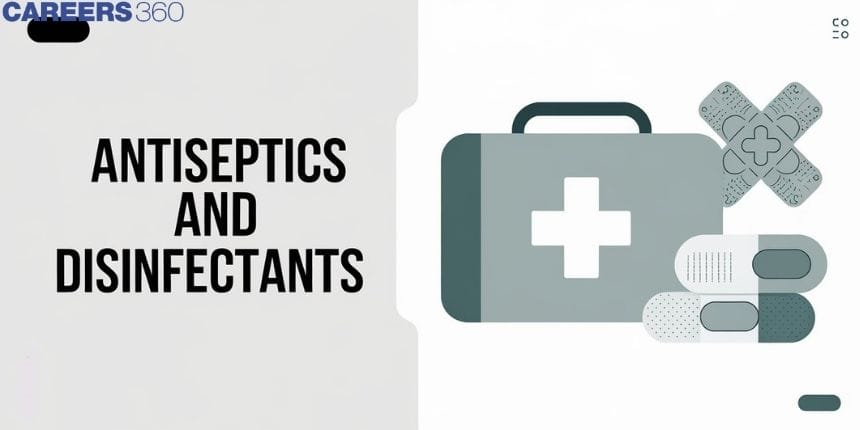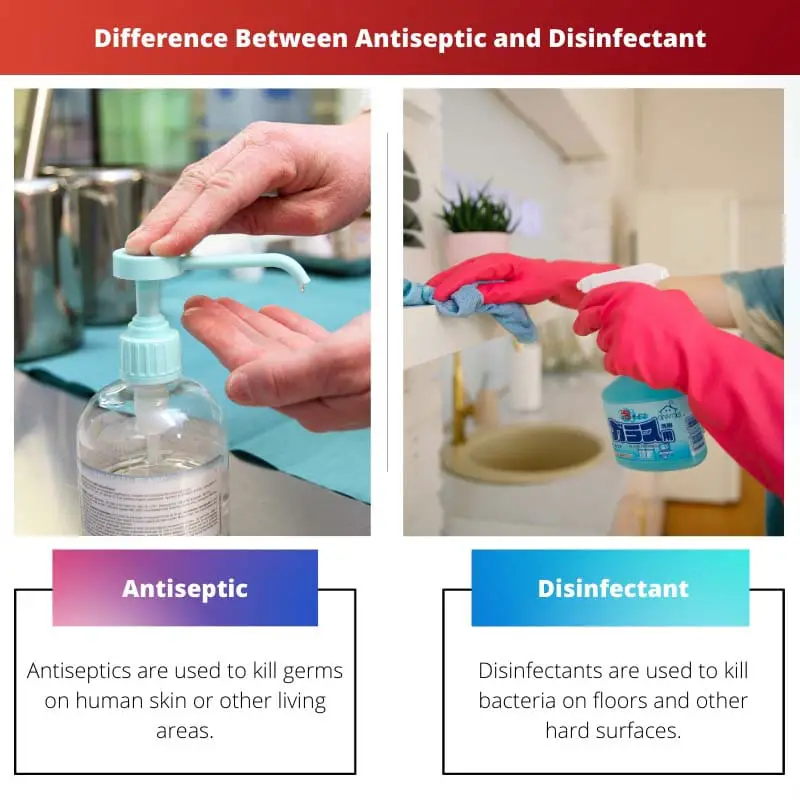Antiseptics And Disinfectants: Types, Difference, Examples, Uses, FAQs
Antiseptics and disinfectants are part and parcel of daily fights against infections in health institutions as well as in ordinary life. Basically, they are chemical agents applied to the body to suppress or completely kill pathogenic microorganisms that can cause infection. Although many times the terms "antiseptic" and "disinfectant" are used to refer to the same thing, their roles are different and important to know for the sake of effective application. While antiseptics are applied to living tissue, like skin, to reduce the chances of infection, disinfectants are used on inanimate surfaces to eradicate paths of pathogens.
NEET 2025: Mock Test Series | Syllabus | High Scoring Topics | PYQs
JEE Main: Study Materials | High Scoring Topics | Preparation Guide
JEE Main: Syllabus | Sample Papers | Mock Tests | PYQs
- How Antiseptics and Disinfectants Work
- The chemicals used for sterilization are classified under two headings:
- Classifications of Antiseptics and Disinfectants
- Relevance and Applications in Real Life
- Some Solved Examples
- Summary:

These agents have come to the fore over the years, with growing world health crises such as the COVID-19 pandemic. The more the people learned hygiene practices, the higher the demands were for antiseptics and disinfectants. Today, from only being used in hospitals, they are part of everyday life—from hospitals to households—a fact underlining the necessity of general knowledge about their functions and types of antiseptics and disinfectants and how they should be used.
How Antiseptics and Disinfectants Work
While antiseptics reduce the number of or completely kill pathogenic microorganisms on living tissues, disinfectants do it on non-living surfaces or inanimate objects. Those two classes of agents are related to the group called biocides, chemicals killing or inhibiting the growth of microorganisms. The difference between them lies in the main point of application: antiseptics are safe for contacting the skin, but disinfectants are not for use on living tissue since more significant concentrations of active ingredients are used in their makeup.
Mechanisms of action in antiseptics and disinfectants are different. The mechanisms of action usually for antiseptics are through either disrupting the normal cell membrane of microorganisms or interfering with their metabolic processes. One example is ethanol hand sanitizers and iodine solutions. In contrast, disinfectants are likely to use many different mechanisms of action, including oxidation or protein denaturation. Examples include bleach and hydrogen peroxide, which have a wide spectrum of activity against a variety of different pathogens. Knowing these mechanisms is important in selecting the appropriate agent for a given situation, since inappropriate use may either result in ineffective disinfection or induce microbial resistance.
The chemicals used for sterilization are classified under two headings:
1. Antiseptics:
The term 'septic' is derived from the Greek word septikos which means putrify or rot. In medicine, it indicates the state of being infected with pus-forming organisms. Anti-infective agents that are applied locally, i.e., applied directly to the skin wounds, cuts, ulcers diseased skin surfaces, etc., are known as antiseptics.
Chemical substances that prevent the growth of microorganisms and kill them but are not harmful to living human tissues are called antiseptics. Some common examples of antiseptics are Dettol, savlon, acriflavin, gentian iodine, iodoform, potassium permanganate, etc.
2. Disinfectants:
These substances kill the microorganisms or stop their growth but are harmful to the human tissues. These are used for sterilization of inanimate objects like instruments, utensils, toilets, drains, floors, and living tissues and cannot be used on the skin. Examples are phenol, methyl phenols, hydrogen peroxide, chlorine, bleaching powder, etc.
The same substances can act as antiseptics or disinfectants depending upon the concentration of the substance in the solution. In smaller concentrations, it is an antiseptic while in higher concentrations it becomes a disinfectant. For example, 0.2% solution of phenol acts as an antiseptic and its 1% solution is a disinfectant.

Classifications of Antiseptics and Disinfectants
Antiseptics and disinfectants can broadly be classified based on their chemical nature and application.
Antiseptics:
- Alcohols:Alcohols are used as constituents of antiseptic lotions, particularly hand sanitizers, with action against bacteria and viruses.
- Chlorhexidine: Used on surgical areas with good activity against most bacteria.
- Iodine-based solutions: Disinfection of the skin before surgery, against bacteria, viruses, and fungi.
- Hydrogen peroxide: It is used in wound cleaning and as mouthwash. It has shown to have antibacterial activity.
- Chlorine compounds: These are broadly used for water disinfection and surface due to its strong antimicrobial activity.
Quaternary ammonium compounds are present in most domestic cleaners and have a wide efficiency against bacteria and some viruses. Phenolic compounds are used in healthcare for the inactivation of a wide range of pathogens. Ultraviolet light may be seen as an upcoming surface and air decontamination method, particularly in healthcare settings.
The application will depend on whether an antiseptic or disinfectant is being used, the intended use, the type of microorganism targeted for control, and safety considerations. Alcohol, for example, is invariably effectual against hand hygiene, but it exerts its solvent properties on surfaces.
Relevance and Applications in Real Life
They do not remain in a clinical setting only; they become very much part of public health and the safety of the people. Antiseptics in a hospital setup are used to take care of the wounds and prevent infections during surgery. Applied before surgery—for instance, chlorhexidine—drastically reduces the risk of surgical site infections. Similarly, disinfectants become very important in ensuring sterile conditions within a hospital setup where nosocomial infections are very easily acquired.
In particular, against the background of the COVID-19 outbreak, disinfectants have been utilized extensively in everyday life. Household disinfectant products, mainly bleach or alcohol, are today's trinities in every household with the view to stopping the virus from spreading on surfaces. On the other hand, hand hygiene has been foregrounded, and antiseptic hand sanitizers are administered when soap and water are not available.
However, their increased use is coupled with concerns of microbial resistance. Research evidence has shown that the overuse of certain disinfectants actually selects and promotes the growth of resistant strains of bacteria, hence challenging infection control. It is hence vital to learn how to use the antiseptics/disinfectants appropriately and under what circumstances they have limitations for the health of individuals and the public.
Basically, the two most important items for infection prevention and control are antiseptics and disinfectants. Their various roles in health and daily life prove that the proper application and knowledge of the mechanism of each are very essential. Their responsible application shall hence be of paramount importance in health protection against infections during our journey through public health challenges.
Some Solved Examples
Example 1
Question: Bithional is generally added to soap as an additive to function as an
1) Softner
2) Dryer
3) Buffering agent
4) Antiseptic (correct)
Solution:
Bithional is used as an antiseptic in medicated soap. Such soaps are used to reduce undesirable odors due to bacterial action on the skin surface.
Correct Option: 4
Example 2
Question: Which among the following is a disinfectant?
1) 0.3 ppm Cl 2 (correct)
2) CHI3
3) Boric acid
4) Morphine
Solution:
Disinfectants are used to kill microorganisms but cannot be applied to living tissues. Examples include chlorine (0.2 to 0.4 ppm), SO2 (low concentration). CHI3 and boric acid are antiseptics, and Morphine is a narcotic analgesic.
Correct Option:1
Example 3
Question: Dettol is the mixture of
1) Chloroxylenol and terpineol (correct)
2) Trimer and pentamer of Azobenzene derivative
3) Chloramphenicol and terpinol
4) Chloroxylenol and chloramphenicol
Solution:
Dettol is a mixture of chloroxylenol and terpineol.
Correct Option: 1
Example 4
Question: Mixture of chloroxylenol and terpineol acts as:
1) Analgesic
2) Antiseptic (correct)
3) Antipyretic
4) Antibiotic
Solution:
A mixture of chloroxylenol and terpineol acts as an antiseptic (Dettol).
Correct Option:2
Example 5
Question: An antiseptic Dettol is a mixture of two compounds 'A' and 'B' where A has 6(pi) electrons and B has 2(pi) electrons. What is 'B'?
1) Bithionol
2) Terpineol (correct)
3) Chloroxylenol
4) Chloramphenicol
Solution:
Dettol is a mixture of chloroxylenol and terpineol.
Correct Option: 2
Summary:
Antiseptics and disinfectants are hence very important aspects of infection prevention and control, wherein both have quite different roles in the environment: antiseptics, applied on living tissues, help to reduce most of the microbial load, and disinfectants are applied to inanimate surfaces, killing pathogens. This therefore calls for differentiation between these two agents so that proper usage can be done. Unless applied appropriately, it will not be efficient for disinfection but will equally enhance microbial resistance.
Frequently Asked Questions (FAQs)
Antiseptics can be defined as antibacterial agents that can be applied to the body of living organisms to prevent the action of microorganisms. Instead of being injected into the body like antibiotics, it is applied to the surface of the skin to repair living tissue in the event of a wound or cut.
A disinfectant can be defined as an antimicrobial agent that can be applied to the surface of some objects in order to destroy the microorganisms present on them.
Use of antiseptics are-
To clean the skin before surgery antiseptics are used.
If the skin or mucous membranes are damaged during surgery, antiseptics are used in the affected area to reduce the possibility of infection.
They are used to wash hands.
Use of disinfectants are-
Hospital instruments are usually disinfected with 2% glutaraldehyde.
Chlorine 0.2-0.5 ppm is used to clean or disinfect water and swimming pools.
3% peroxide is used on skin, minor wounds and mucous membranes to kill bacteria.
Some common examples of antiseptics are listed below-
Alcohol: Alcohols such as isopropyl alcohol and ethyl alcohol are used to disinfect the skin before needling. It is also used in hand sanitizers.
Lysol: These compounds are used both as disinfectants and disinfectants. It is used for household and industrial cleaning.
Iodine (povidone-iodine): a well-known antiseptic that is used to disinfect the skin before and after surgery.
Also Read
02 Jul'25 07:53 PM
02 Jul'25 07:48 PM
02 Jul'25 07:48 PM
02 Jul'25 07:48 PM
02 Jul'25 05:25 PM
02 Jul'25 05:25 PM
02 Jul'25 05:24 PM
02 Jul'25 05:24 PM
02 Jul'25 05:24 PM

